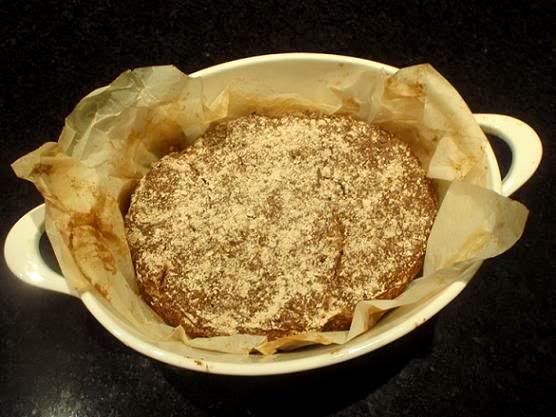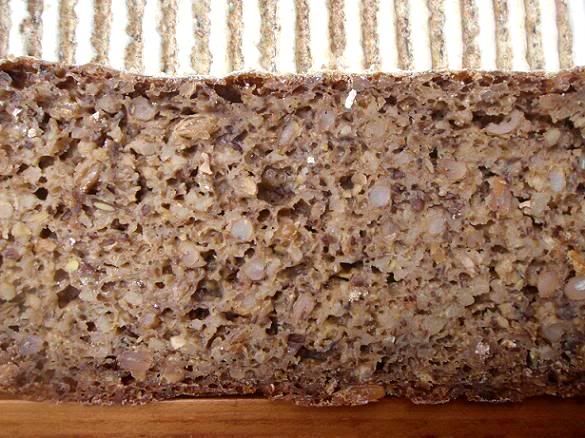
Horst Bandel's Black Pumpernickel
1983, I was in my mid-20's in Boston doing my final year of post graduate studies under Rotary scholarship. A memorable year as it was the first time ever in my life that I went overseas. My host family, Bob, is from Armenia and Maria, Germany; both came to America in their late teens. One day they drove me to New York to visit the Metropolitan Museum. We had lunch at a posh side walk cafe; the waiter brought us curious black color bread rolls. As Maria was eating, she couldn't stop raving about these dense looking bread rolls which had (I subsequently learnt) a faint caraways fragrance. To this day I still remember how she was telling me that breads are supposed to be dense and flavorful, not like those fluffy, light stuff from supermarkets.
As I've been baking a lot of sourdough breads lately, I think of Bob and Maria a lot. It was sort of a fluke that I started reading about the story of Horst Bandel, a local minister who bought breads from Jeffrey Hamelman's bakery in Vermont years and years ago (page 221 of Hamelman's Bread: A Baker's Book of Technique and Recipes). Horst Bandel's family owned a bakery for 150 years in Germany; he was going to take over the bakery but had to flee to America because of the 2nd World War. He became a minister and had not baked since.... until he and Hamelman got together to bake this black pumpernickel of his youth.
Horst's family used a wood-fired oven for all their baking; this Black Pumpernickel would go into the oven last of all when they finished baking the day's bread, and baked (in covered pan) overnight in the lingering heat of the oven. "Next morning, we would pull it from the oven, dark, dense, and fragrant," as he described it to Hamelman.
Well, I made this Black Pumpernickel in memory of Bob & Maria, and my Boston days.

Horst Bandel's Black Pumpernickel, baked as a normal sourdough bread

Horst Bandel's Black Pumpernickel, baked in covered casserole pan, in medium low heat as per Halmelman's instruction
Formula was based on page 221 - 224 of Jeffrey Hamelman's Bread: A Baker's Book of Techniques and Recipes. Total dough weight was 1.8 kg which I separated into two pieces and baked differently as the pictures above show.


The crumb
Shiao-Ping


Comments
Shiao-Ping
I'm happy to see that you also have been taken by Mr Hamelman's writing style in his book "Bread". The genuine effort to embrace the emotions and motivation of Mr Bandel are remarkable and why I enjoy this author like no other.
The crumb image looks wonderful. Was there much difference in the results of the two baking methods? I suspect the image is from the covered version. Did you stick to the ingredients list strictly?
Eric
The ingredients - You ask the question of an informed baker. The 5 key ingredients on the list are:
rye meal 30%
rye berries 20% (a soaker)
rye chops 25%
high gluten flour 25%
old bread 20% (another soaker)
My problem is rye chops, which are chopped (not ground) rye berries that are either fine, medium or coarse. As it makes up 100% of the baker's percentage, I decided that it should be more fine than coarse. There is no supply here that I know of, so I have to improvise. I ended up using 1/2 chopped wheat berries and 1/2 linseed meal to substitute for it. On hindsight, I could have used my super-duper blender to see if it can chop them.
Secondly, I only needed 41% of the 12.8 oz water from the final dough formula because of the moisture from the old bread which was previously soaked. The instruction says to squeeze out as much liquid as possible from the old bread soaker, but, really, after it being soaked for 4 hours, you couldn't do that very well. This liquid is to be reserved for later use if necessary and the dough consistency we look for is "medium consistency but not wet, and it will be slightly sticky." Well, as I said, I only used 41% of the 12.8 oz of water and the dough already reached the required consistency.
The color of my pumpernickel is not very black as it was majority white old sourdough that I usedfor the old bread soaker.
The fermentation - I let the dough ferment longer than the instruction calls for because I wanted to see it rise and on hindsight I should not have done that. For the smaller dough, however, I cold retarded it in the refrigerator before I baked it as a normal sourdough in 230C/446F a day later than the covered version.
The crumb - Yes, the crumb photo is from the covered version. It is very moist and very easy to have, considering it is loaded with berries, not exceedingly chewy. The taste is at once sourness and sweetness.
I wanted to wait 24 hours before I slice the smaller pumpernickel and that's why its crumb photo was not in the post yesterday. I've just sliced it for breakfast and here it is:
crumb of the smaller Black Pumpernickel
It is a little bit dryer than the covered version, but still moist enough. It tastes more full-flavor than the covered version; I don't know if it is because it was cold retarded or simply because it is a little dryer so the flavor is more concentrated. For comparison, I had a slice of the covered version again, and, gee, 48 hours on, it tastes even better than yesterday.
For Asians, pumpernickel breads are not normally appealing, just too grainy. But I have to say, Horst Bandel's Black Pumpernickel is as good as it can get.
Shiao-Ping
Hi Shiao-Ping,
What a wonderful job you did with these breads! I just got back from visiting my wife Heidi's parents in Edmonton, Alberta in Canada ...German immigrants (like my family) for Christmas. As a part of the feast that they provided us were some loaves of black pumpernickel that had been imported from Germany. It was very very good, dark in color (darker than yours by twice), had a crumb very similar to the one that you baked in a covered bowl (only slightly denser yet), and a flavor that was grainy, slightly sour, and slightly sweet all at the same time. Heidi's mom said she makes pumpernickel like that and uses a bit of black molasses in it in addition to the grains. All in all, it sounds like your rendition of Horst Bandel's black pumpernickel came out very very close to what you'd actually find in the better bakeries of Germany.
I think I will now bake twice or maybe 3 times ...once to produce a black bread of any kind that will be used as the 'old bread' in the recipe above, then once exactly as specified (but will use a covered bowl or maybe a pullman pan ...most pumpernickels are shaped like a brick from what I can see), then maybe once more with a bit of black molasses added like my mother-in-law does. My wife will be tickled pink ...her favorite bread in the world, just a bit more than ciabatta, is a good dense black pumpernickel from Germany. It'll go great with the product of my other new hobby ...cheese making! (My "slow foods" hobby list now includes bread, cheese, cured and fresh sausages and other smoked products ...and they wonder why I am fat?)
Thanks!
Brian
I remember your ciabatta phase.... Thanks for the long comment. Would love to see your baking if you get a chance for posting.
Thanks again, Shiao-Ping
Thank you for the inspiration, Shiao-Ping. I'm finally going to get Hamelman's book. I bought this kind of bread in a store about 2 years ago and I loved it but haven't been able to find any since then. I've tried making it numerous times but my attempts always fall short.
-greg